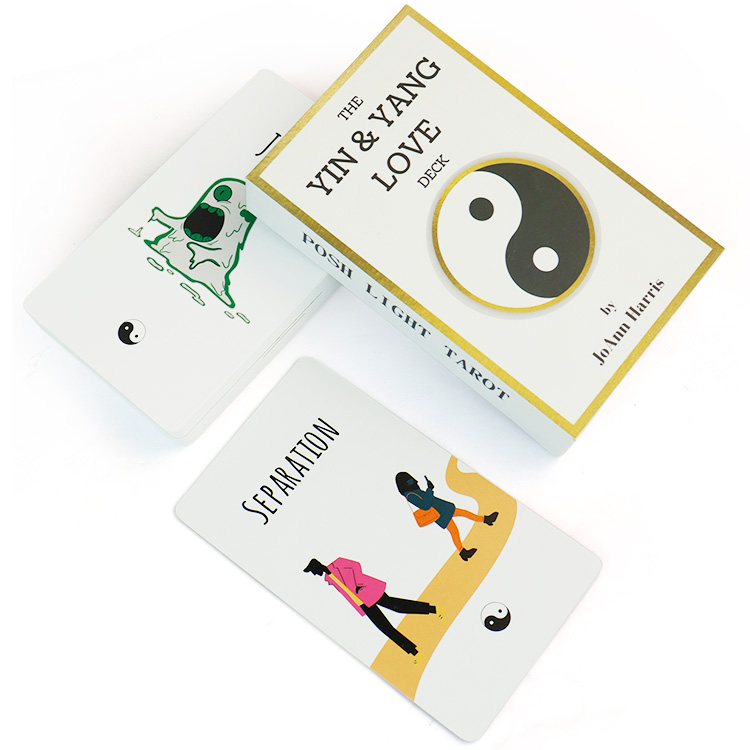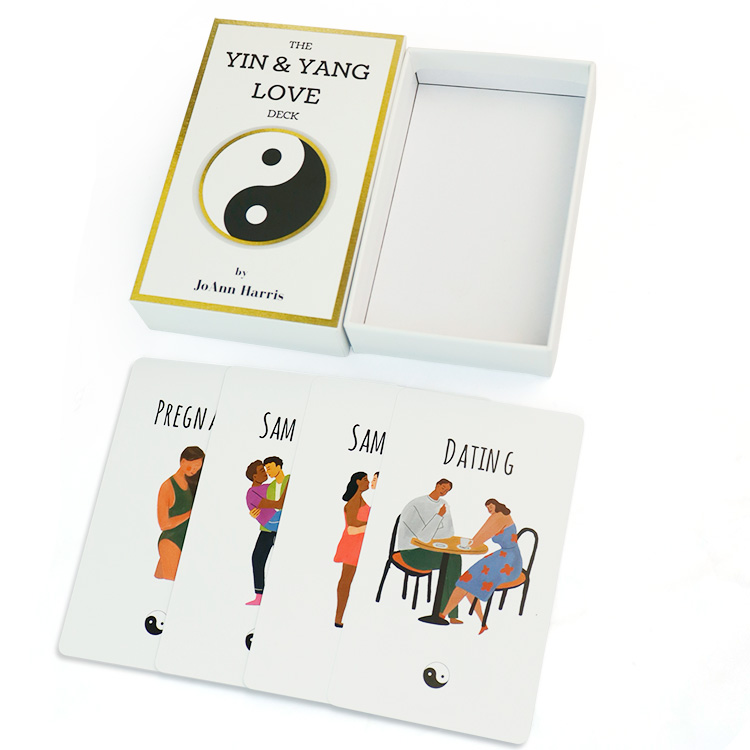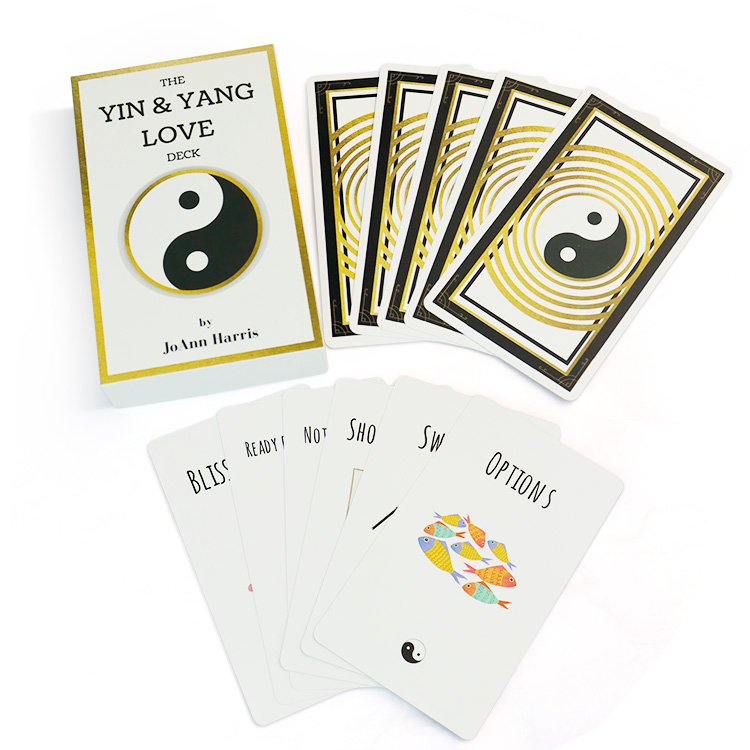The Harmony of Two Worlds: Where Eastern Philosophy Meets Western Symbolism in Yin Yang Tarot Cards
In the space between traditions, where Eastern philosophy meets Western symbolism, a new form of spiritual art emerges. Yin Yang tarot cards represent more than just a fusion of aesthetic styles—they embody a deep philosophical dialogue between two great wisdom traditions. These extraordinary decks seamlessly blend the mystical symbolism of Western esotericism with the elegant minimalism of Eastern art, creating tools for introspection that speak to the modern seeker's global consciousness. Discover how Yin Yang tarot cards create harmony from apparent opposites, offering a unique path to understanding that honors both traditions while transcending their boundaries.
- Chapter 1: The Philosophical Foundation - Balancing Dualities
- Chapter 2: Artistic Synthesis - When Brushstrokes Meet Symbolism
- Chapter 3: Iconic Cards Reimagined - East-West Dialogues
- Chapter 4: The Artist's Journey - Bridging Traditions
- Chapter 5: Reading with Integrated Awareness
- Conclusion: Toward a Global Spiritual Language
Chapter 1: The Philosophical Foundation - Balancing Dualities
Understanding the core principles that make Yin Yang tarot cards uniquely powerful.
-
The Tao of Tarot: Flowing with Universal Energy
At the heart of Yin Yang tarot cards lies the ancient Chinese concept of Yin and Yang—the understanding that all existence emerges from the dynamic interplay of complementary forces. Unlike Western either-or thinking, this Eastern perspective embraces paradox, seeing light within darkness and activity within stillness. This philosophical foundation transforms how each card is interpreted, encouraging seekers to find balance rather than choose sides. -
Western Archetypes, Eastern Expression
Traditional tarot archetypes undergo a fascinating transformation in Yin Yang tarot cards. The Emperor becomes less about domination and more about harmonious governance; The High Priestess embodies the receptive Yin wisdom rather than secret knowledge; The Fool's journey reflects the Taoist concept of Wu Wei—effortless action. This reinterpretation preserves the core meanings while expanding their philosophical depth. -
The Five Elements Meet the Four Suits
Yin Yang tarot cards often integrate the Chinese Wu Xing (five elements) system with traditional tarot suits. Wands might correspond with Wood's creative energy, Cups with Water's fluidity, Swords with Metal's precision, and Pentacles with Earth's stability. The fifth element, Fire, often represents the transformative spark that moves through all the cards, creating a more nuanced elemental language. -

Chapter 2: Artistic Synthesis - When Brushstrokes Meet Symbolism
Exploring the unique visual language of Yin Yang tarot cards.
-
The Poetry of Empty Space
Where Western tarot art often fills every corner with symbolic detail, Yin Yang tarot cards embrace the Chinese artistic principle of "liu bai" or "staying white." This intentional use of negative space isn't emptiness but rather active silence that allows the viewer's intuition to participate in completing the image. A single cherry blossom branch against vast white space in The Star card can convey more than a detailed night sky filled with constellations. -
Calligraphy as Sacred Geometry
In Yin Yang tarot cards, Chinese characters often replace or complement traditional titles, with each brushstroke carrying both semantic meaning and aesthetic power. The physical energy of the brushwork—the pressure, speed, and rhythm—becomes part of the card's message, transforming written words into living embodiments of the concepts they represent. -
Ink Wash Ambiguity and Multiple Interpretations
The flowing, unpredictable nature of ink wash painting in Yin Yang tarot cards creates images that resist fixed meanings. A mountain in The Hermit card might simultaneously suggest stability, solitude, and the upward journey toward enlightenment. This artistic ambiguity encourages personal interpretation and meditation rather than rote memorization of standard meanings. -

Chapter 3: Iconic Cards Reimagined - East-West Dialogues
Examining how specific major arcana cards transform through cultural integration.
-
The Wheel of Fortune as Taijitu
In Yin Yang tarot cards, The Wheel of Fortune often becomes a dynamic visualization of the Taijitu symbol—the familiar Yin Yang circle. The black and white teardrops swirl in eternal motion, with the small dots of opposite color reminding us that every turning contains the seed of its opposite. The four fixed signs of the zodiac in traditional Rider-Waite imagery might transform into the four celestial animals of Chinese cosmology—Azure Dragon, Vermilion Bird, White Tiger, and Black Tortoise. -
Temperance as The Taoist Alchemist
The Western card of Temperance, already about blending opposites, finds perfect expression in Yin Yang tarot cards as a Taoist sage practicing internal alchemy. Rather than an angel mixing waters, we might see a meditative figure circulating energy between the upper and lower dantians (energy centers), physically embodying the balance of fire and water, heart and kidney, consciousness and essence. -
The World as The Uncarved Block
Where Western tradition shows a dancing figure surrounded by a wreath, Yin Yang tarot cards might represent The World through the Taoist concept of Pu—the uncarved block. This paradoxical image of completion as potential, perfection as simplicity, captures the Eastern understanding that true wholeness includes both form and formlessness, movement and stillness. -

Chapter 4: The Artist's Journey - Bridging Traditions
The creative process behind designing culturally integrated decks.
-
Research and Respectful Integration
Creating authentic Yin Yang tarot cards requires deep engagement with both traditions. Artists typically immerse themselves in Western esoteric literature while studying Eastern philosophy and art history, seeking natural points of convergence rather than forced combinations. This respectful approach ensures the fusion feels organic rather than appropriative. -
Intuitive Synthesis Over Literal Translation
The most successful Yin Yang tarot cards emerge from intuitive understanding rather than intellectual mapping. Artists often meditate on each card's essence, allowing Eastern expressions to emerge naturally rather than deciding in advance how to "convert" Western symbols. This process frequently reveals surprising connections that logical analysis might miss. -
Balancing Authenticity with Accessibility
Artists creating Yin Yang tarot cards walk a delicate line between cultural authenticity and user-friendly design. While incorporating genuine philosophical concepts and historical art styles, they must also ensure the cards remain accessible to users from various backgrounds who may be unfamiliar with one or both traditions. -

Chapter 5: Reading with Integrated Awareness
How to work with Yin Yang tarot cards for deeper insight.
-
Seeing Patterns Rather Than Positions
Traditional tarot spreads often emphasize positional meanings, but Yin Yang tarot cards encourage viewing readings as dynamic energy patterns. Instead of "past-present-future," a three-card spread might be contemplated as "Yin-Yang-Unity" or "Foundation-Expression-Integration," with the relationships between cards revealing the flowing balance of energies. -
Embracing Paradox in Interpretation
Working with Yin Yang tarot cards cultivates comfort with apparent contradictions. The Tower might simultaneously represent necessary destruction and the emptiness from which new creation emerges. The Lovers could signify both heartfelt connection and the solitude within relationship. This both-and approach expands interpretive possibilities. -
Meditative Rather Than Analytical Engagement
While Western tarot practice often involves detailed symbolic analysis, Yin Yang tarot cards respond well to meditative contemplation. Sitting with a single card, observing its brushwork, breathing with its rhythms, and allowing meanings to emerge spontaneously often yields insights that systematic study cannot provide. -

Conclusion: Toward a Global Spiritual Language
Yin Yang tarot cards represent more than an artistic novelty—they signal the emergence of a global spiritual language that honors cultural specificity while transcending geographical boundaries. In a world often divided by apparent differences, these integrated decks remind us that wisdom traditions, despite their varied expressions, ultimately point toward the same universal truths about human nature and cosmic order.
The true power of Yin Yang tarot cards lies in their ability to help us hold multiple perspectives simultaneously—to see the structured symbolism of the West and the flowing philosophy of the East not as competitors but as complementary voices in humanity's eternal conversation about meaning, purpose, and connection. As we shuffle these culturally blended decks, we participate in weaving together the world's wisdom traditions, creating something new yet ancient, familiar yet surprising—much like the spiritual journey itself.
In the harmonious interplay of Eastern and Western traditions, we find not confusion but clarity—the kind that emerges when we stop choosing between different ways of seeing and learn instead to appreciate the unique vision each tradition brings to our understanding of the great mystery we all seek to navigate.

Top 5 Creative Ways to Personalize Your Playing Cards for Branding

The Feelings Game Night: How Emotion Guessing Game Cards Transform Parties into Journeys of Connection and Self-Discovery

Social Bridge Builder: How Conversation Game Cards Transform Awkward Moments into Meaningful Connections

How to Choose the Right Material for Your Custom Card Decks

The Positivity Playground: How Affirmation Card Games Transform Team Building and Corporate Culture
About product selection
Is there a design template I can use?
Yes, we provide design templates for different card types. You can download them from our website or request them directly from our team.
After-sales support
Can I order a sample before placing a formal order?
Yes, we can provide samples for your review. Please contact us to discuss pricing and options for samples.
Do you offer eco-friendly options?
Yes, we do offer eco-friendly materials and printing options. Please inquire about our sustainable options.
About cooperation process
How do you ensure the quality of your cards?
We implement strict quality control measures at every stage of production. Our team conducts thorough inspections to ensure each card meets our high standards before shipping.
How long does the OEM process take?
The time depends on the complexity of the project, but generally OEM orders take about 6 weeks from design confirmation to delivery.






WE’D LOVE TO 
FROM YOU
Please send us your inquiry details; our team will contact you ASAP.
20+ years of experience in custom playing cards, game cards, tarot cards, flashcards, and board games, as well as paper and paperboard box manufacturing.

bbilaser
sq_AL